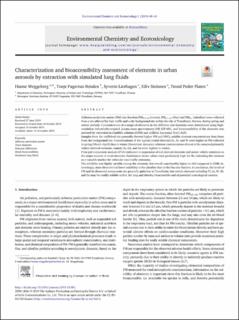| dc.contributor.author | Weggeberg, Hanne | |
| dc.contributor.author | Benden, Tonje Fagertun | |
| dc.contributor.author | Lierhagen, Syverin | |
| dc.contributor.author | Steinnes, Eiliv | |
| dc.contributor.author | Flaten, Trond Peder | |
| dc.date.accessioned | 2020-02-26T19:16:42Z | |
| dc.date.available | 2020-02-26T19:16:42Z | |
| dc.date.created | 2019-12-18T09:37:04Z | |
| dc.date.issued | 2019 | |
| dc.identifier.citation | Environmental Chemistry and Ecotoxicology. 2019, vol 1, 49-60. | en_US |
| dc.identifier.issn | 2590-1826 | |
| dc.identifier.uri | https://hdl.handle.net/11250/2644056 | |
| dc.description.abstract | Airborne particulate matter (PM) size fractions PM2.5–10 (coarse), PM0.1–2.5 (fine) and PM0.1 (ultrafine) were collected from a site affected by high traffic and a city background site within the city of Trondheim, Norway during spring and winter periods. Concentrations of a range of elements in the different size fractions were determined using high-resolution inductively-coupled plasma mass spectrometry (HR-ICP-MS), and bioaccessibility of the elements was assessed by extraction in Gamble's solution (GMB) and artificial lysosomal fluid (ALF).
Samples from the trafficked site generally showed higher PM and HNO3 soluble element concentrations than those from the background site. Concentrations of the typical crustal elements Sc, Al, and W were higher in PM collected in spring (March–April) than in winter (December–January), whereas concentrations of most of the assumed primarily vehicle-derived elements, namely As, Cd, and Cu were highest in winter.
Principal component analysis (PCA) indicated re-suspension of soil-derived elements and motor vehicle emissions as the major sources of most elements. Enrichment factor values were particularly high for Sb, indicating this element as a valuable marker for vehicular road traffic emissions.
The solubility was highly variable among the elements, but overall considerably higher in ALF compared to GMB. Interestingly, most elements had lower solubility in the ultrafine than in the fine size fraction. In conclusion, the levels of PM and its elemental components are generally quite low in Trondheim, but certain elements including Tl, As, W, Sb, and Cu may be readily soluble within the lung and thereby bioaccessible and of potential toxicological concern. | en_US |
| dc.language.iso | eng | en_US |
| dc.rights | Attribution-NonCommercial-NoDerivatives 4.0 Internasjonal | * |
| dc.rights | Attribution-NonCommercial-NoDerivatives 4.0 Internasjonal | * |
| dc.rights.uri | http://creativecommons.org/licenses/by-nc-nd/4.0/deed.no | * |
| dc.title | Characterization and bioaccessibility assessment of elements in urban aerosols by extraction with simulated lung fluids | en_US |
| dc.type | Journal article | en_US |
| dc.description.version | publishedVersion | en_US |
| dc.source.pagenumber | 49-60 | en_US |
| dc.source.volume | 1 | en_US |
| dc.source.journal | Environmental Chemistry and Ecotoxicology | en_US |
| dc.identifier.doi | http://dx.doi.org/10.1016/j.enceco.2019.10.001 | |
| dc.identifier.cristin | 1762308 | |
| cristin.unitcode | 192,0,0,0 | |
| cristin.unitname | Norges miljø- og biovitenskapelige universitet | |
| cristin.ispublished | true | |
| cristin.fulltext | original | |

